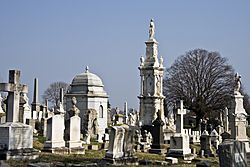Loudon Park Cemetery facts for kids
Loudon Park Cemetery is a historic and large cemetery located in Baltimore, Maryland. It was started on January 27, 1853, on a big piece of land that used to be part of the "Loudon" estate. This estate belonged to James Carey, a local businessman and politician. The main entrance to the cemetery is on Wilkens Avenue.
Both Loudon Park Cemetery and the Loudon Park Funeral Home are owned and run by local people. They became privately owned in 2014. Before that, they were part of larger companies. The funeral home was built in 1995 on the cemetery grounds.
A Special Place for Soldiers: National Cemetery
A part of Loudon Park Cemetery is owned by the United States government. This section is called Loudon Park National Cemetery. It was bought in 1861. About 2,300 Union soldiers who died during the American Civil War are buried here.
There is also a special section for Confederate soldiers. Around 650 Confederate soldiers are buried there. This area has a statue of a Confederate soldier. Since 2003, many of the Confederate graves have received new markers. This happened through a program where people could "adopt" a Confederate soldier's grave. The entrance to the National Cemetery part of Loudon Park is on Frederick Avenue.
Famous People Buried Here
Many interesting and important people are buried at Loudon Park Cemetery. Here are some of them:
- Thomas Beck (1909–1995): An actor.
- Charles Joseph Bonaparte (1851–1921): He was a former top lawyer for the U.S. government (United States Attorney General). He also led the U.S. Navy (United States Secretary of the Navy). He helped start the Federal Bureau of Investigation (FBI).
- Jerome Napoleon Bonaparte (1805–1870): He was the son of Jérôme Bonaparte and the nephew of Emperor Napoleon I. He was also the father of Charles Joseph Bonaparte.
- William Samuel Booze (1862–1933): A U.S. Congressman from Maryland.
- Abel G. Cadwallader (1841–1907): A soldier in the Civil War who received the Medal of Honor for his bravery.
- Jack L. Chalker (1944–2005): A well-known author.
- Barnes Compton (1830–1898): A former Congressman and Maryland state Treasurer.
- Frederick Nicholls Crouch (1808–1896): A composer who wrote music.
- Elijah Cummings (1951–2019): A U.S. Congressman from Maryland for many years.
- Frederick George D'Utassy (1827–1892): A Union Army officer during the Civil War.
- David Danforth (1890–1970): A Major League Baseball player.
- James William Denny (1838–1923): A Confederate Army officer in the Civil War and a U.S. Congressman.
- Lewis Pessano "Buttercup" Dickerson (1858–1920): A Major League Baseball player.
- Charles W. Field (1828–1892): A military officer who served in the United States, Confederate, and Egyptian armies.
- John T. Ford (1829–1894): He operated Ford's Theater, a famous theater.
- James Albert Gary (1833–1920): A former United States Postmaster General, who was in charge of the U.S. mail.
- Harry Gilmor (1838–1883): A Confederate cavalry officer and Baltimore City Police Commissioner.
- Bradley T. Johnson (1829–1903): A writer and a Confederate Brigadier General. He led the 1st Maryland Regiment.
- William Kimmel (1812–1886): A U.S. Congressman from Maryland.
- William W. McIntire (1850–1912): A U.S. Congressman from Maryland.
- H. L. Mencken (1880–1956): A famous journalist, critic, author, and essayist.
- Ottmar Mergenthaler (1854–1899): He invented the Linotype machine, which changed how newspapers were printed.
- Mary Young Pickersgill (1776–1857): She was the seamstress who made the large flag that flew over Fort McHenry during the Battle of Baltimore. This flag inspired Francis Scott Key to write "The Star-Spangled Banner".
- Robert John Reynolds (1838–1909): A former governor of Delaware.
The Weiskittel-Roehle Burial Vault is a special burial place made with cast iron. It was added to the National Register of Historic Places in 1976 because of its historical importance.
Images for kids
-
Mary Pickersgill tombstone and plaque
-
Monument for General Bradley T. Johnson, Confederate States Army
-
Abel Cadwallader, Union soldier and Medal of Honor recipient
















